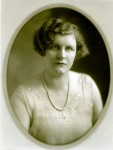 Evelyn Louise Way was born in Ontario, Canada, in 1893. She graduated from nursing school in 1916 and worked as a nurse. In 1926 she married Massachusetts industrialist Henry Plimpton Kendall who had turned a small, unsuccessful textile mill owned by his mother’s family (the Plimptons of Walpole, MA, whose scions include journalist George Plimpton and actress Martha Plimpton) into a hugely successful textile manufacturing company of national scope. Bought by Palmolive in the 1970s, the Kendall Company still lives today through brands like Curad bandages.
Evelyn Louise Way was born in Ontario, Canada, in 1893. She graduated from nursing school in 1916 and worked as a nurse. In 1926 she married Massachusetts industrialist Henry Plimpton Kendall who had turned a small, unsuccessful textile mill owned by his mother’s family (the Plimptons of Walpole, MA, whose scions include journalist George Plimpton and actress Martha Plimpton) into a hugely successful textile manufacturing company of national scope. Bought by Palmolive in the 1970s, the Kendall Company still lives today through brands like Curad bandages.
Both Evelyn and Henry were avid philanthropists and collectors with a broad range of interests. Together they assembled museum-quality collections that would eventually become the kernels of more than one museum. Their collection of early South Carolina maps and prints they donated to the University of South Carolina. Evelyn put her collection of dolls on display in the Kendall Doll Museum, now alas closed and the collection dispersed at auction. She donated her collection of antique clothing to the Royal Ontario Museum. The Way’s extensive, world-class collection of whaling artifacts went on display in the Kendall Whaling Museum in 1950, also now closed. The collection was donated to the New Bedford Whaling Museum in 2001.
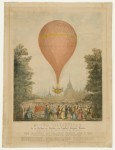 Perhaps Evelyn Way Kendall’s greatest feat of collecting was the three decades she spent assembling the largest private collection of early aviation memorabilia. We don’t know what inspired this passion for aviation in Evelyn. One possible catalyst was a widely publicized rescue mission of lost balloonists that her father William Beal Way, a regional supervisor with the Canadian National Railroads, had participated in. In December of 1920, two U.S. Navy balloonists had been blown way off course from Long Island to the frozen hinterlands of Hudson Bay. The balloon was lost in the crash but the balloonists survived, braving hunger, Canada’s inclement December-January weather, and long distance travel on foot and by dog sled. William Way wrote a detailed account of their month-long ordeal and rescue which Evelyn apparently found riveting.
Perhaps Evelyn Way Kendall’s greatest feat of collecting was the three decades she spent assembling the largest private collection of early aviation memorabilia. We don’t know what inspired this passion for aviation in Evelyn. One possible catalyst was a widely publicized rescue mission of lost balloonists that her father William Beal Way, a regional supervisor with the Canadian National Railroads, had participated in. In December of 1920, two U.S. Navy balloonists had been blown way off course from Long Island to the frozen hinterlands of Hudson Bay. The balloon was lost in the crash but the balloonists survived, braving hunger, Canada’s inclement December-January weather, and long distance travel on foot and by dog sled. William Way wrote a detailed account of their month-long ordeal and rescue which Evelyn apparently found riveting.
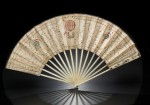 Whatever the origin story, from the 1920s until the 1950s, Evelyn amassed 78 original artworks, more than 400 prints, 330 books and manuscripts, historic photographs, portraits, aircraft designs and decorative objects from fans to snuff boxes to jewelry, all relating to ballooning, aeronauts and aeronautical history. Aviation was a popular subject for collectors at that time, thanks largely to the explosion of interest in the use of aeronautics — the Red Baron, the Zeppelin raids — during World War I. The likes Harry
Whatever the origin story, from the 1920s until the 1950s, Evelyn amassed 78 original artworks, more than 400 prints, 330 books and manuscripts, historic photographs, portraits, aircraft designs and decorative objects from fans to snuff boxes to jewelry, all relating to ballooning, aeronauts and aeronautical history. Aviation was a popular subject for collectors at that time, thanks largely to the explosion of interest in the use of aeronautics — the Red Baron, the Zeppelin raids — during World War I. The likes Harry  Frank Guggenheim and Vanderbilt relation William A.M. Burden collected aviation material, but even with their endlessly deep pockets, they came nowhere near breadth and quality of Evelyn Way Kendall’s collection. As early as 1931, scholars were already beating down her door for access to it.
Frank Guggenheim and Vanderbilt relation William A.M. Burden collected aviation material, but even with their endlessly deep pockets, they came nowhere near breadth and quality of Evelyn Way Kendall’s collection. As early as 1931, scholars were already beating down her door for access to it.
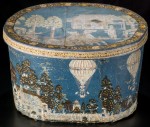 The collection remained in the family after Evelyn’s death in 1979. In 2014, her descendants donated the Evelyn Way Kendall Ballooning and Early Aviation Collection to the Smithsonian’s National Air and Space Museum. After documentation and conservation by Smithsonian experts, the unique collection is now going on display for the first time.
The collection remained in the family after Evelyn’s death in 1979. In 2014, her descendants donated the Evelyn Way Kendall Ballooning and Early Aviation Collection to the Smithsonian’s National Air and Space Museum. After documentation and conservation by Smithsonian experts, the unique collection is now going on display for the first time.
When the first balloon rose over the rooftops of Paris in the late 18th century, enormous crowds gathered to watch. This phenomenon spurred a new age of aeronauts dreaming of what else could fly. The excitement of this achievement was captured much like it would be today—in artwork and on memorabilia; objects such as decorative fans, china, snuff boxes and prints will be on display. “Clouds in a Bag” explores the fascination of the first balloon flights through these pieces.
“The invention of the balloon struck the men and women of the late 18th century like a thunderbolt,” said Tom Crouch, senior curator of aeronautics at the National Air and Space Museum. “After centuries of dreaming, we were airborne at last! Visitors to the exhibition will be able to share some of the excitement experienced by those who watched the first aerial travelers rise into the sky.”
The Clouds in a Bag exhibition opens at the National Air and Space Museum’s Udvar-Hazy Center in Chantilly, Virginia, on Saturday, January 28th, and runs through 2018.
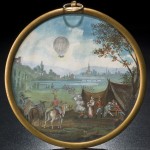
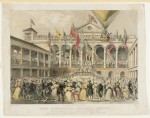


Even if English is not my first language, and Latin/ Greek are not either, and of course the relevant definitions might differ, the terms ‘aviation‘ and ‘aeronautics‘ should not be mixed up. In an attempt to be precise, aviation (‘to fly like a bird’) is derived from aeronautics (to ‘float around in hope for wind’). Thus, what we are talking about is ‘aeronautics’.
Unsure if she collected pieces of art, when it comes to ‘aviation‘, my personal favorite is cycling world champion, stunt cyclist and motorcyclist, automobile racer, stunt driver, pioneer aviator, wartime ambulance driver, and director of a military hospital Hélène Dutrieu(x), b. in 1877. She seems to have been the first woman pilot to fly with a passenger in April 1910.
Did she say “Ehvelyn” or “Eevelyn”?
The Book “Birdmen”, by Lawrence Goldstone, captures both aviation and aeronautics in the early years nicely in it’s early chapters.